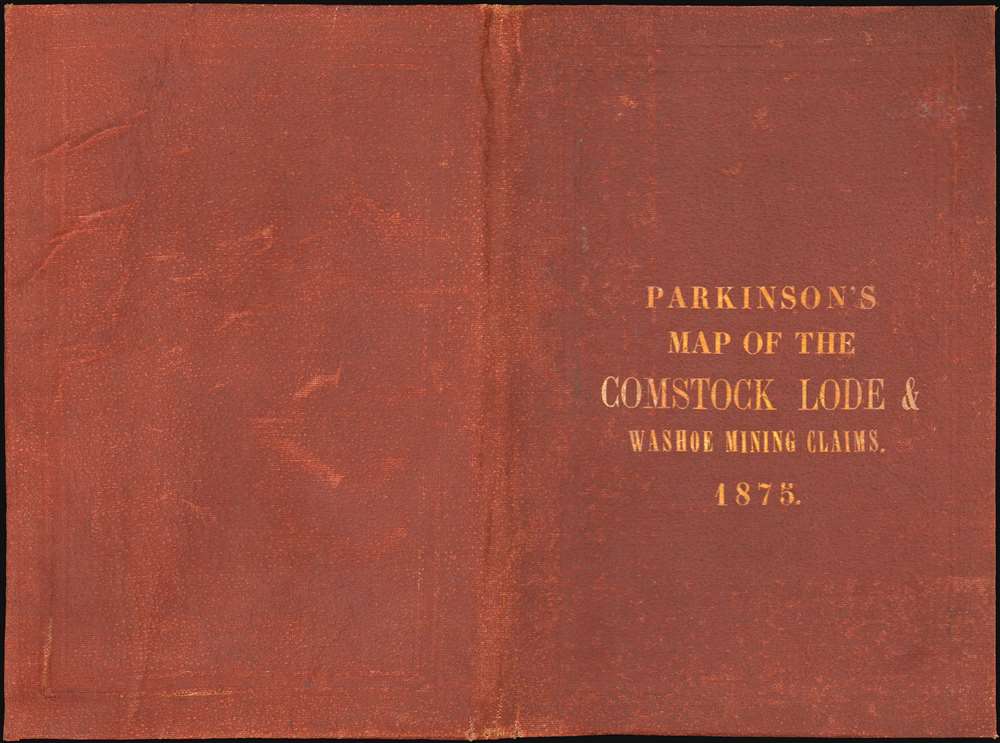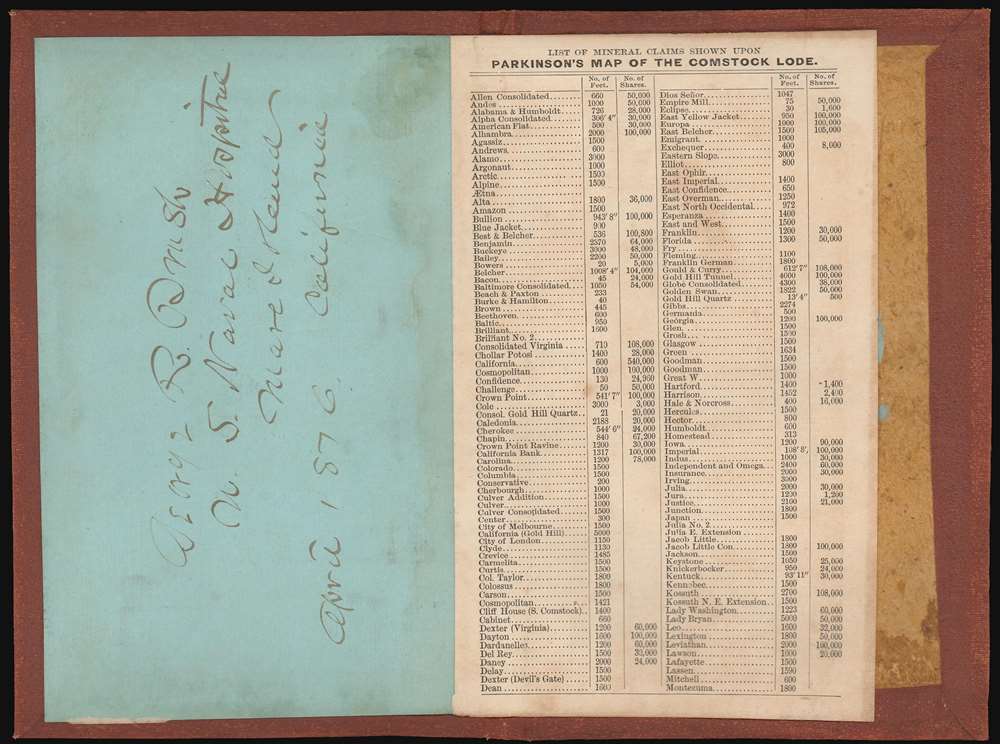Digital Image: 1875 Parkinson Map of the Comstock Lode, Nevada
ComstockLode-parkinson-1875_d
Title
1875 (dated) 21.5 x 31.25 in (54.61 x 79.375 cm) 1 : 12000
Description
FOR THE ORIGINAL ANTIQUE MAP, WITH HISTORICAL ANALYSIS, CLICK HERE.
Digital Map Information
Geographicus maintains an archive of high-resolution rare map scans. We scan our maps at 300 DPI or higher, with newer images being 600 DPI, (either TIFF or JPEG, depending on when the scan was done) which is most cases in suitable for enlargement and printing.
Delivery
Once you purchase our digital scan service, you will receive a download link via email - usually within seconds. Digital orders are delivered as ZIP files, an industry standard file compression protocol that any computer should be able to unpack. Some of our files are very large, and can take some time to download. Most files are saved into your computer's 'Downloads' folder. All delivery is electronic. No physical product is shipped.
Credit and Scope of Use
You can use your digial image any way you want! Our digital images are unrestricted by copyright and can be used, modified, and published freely. The textual description that accompanies the original antique map is not included in the sale of digital images and remains protected by copyright. That said, we put significant care and effort into scanning and editing these maps, and we’d appreciate a credit when possible. Should you wish to credit us, please use the following credit line:
Courtesy of Geographicus Rare Antique Maps (http://www.geographicus.com).
How Large Can I Print?
In general, at 300 DPI, you should at least be able to double the size of the actual image, more so with our 600 DPI images. So, if the original was 10 x 12 inches, you can print at 20 x 24 inches, without quality loss. If your display requirements can accommodate some loss in image quality, you can make it even larger. That being said, no quality of scan will allow you to blow up at 10 x 12 inch map to wall size without significant quality loss. For more information, it is best consult a printer or reprographics specialist.
Refunds
If the high resolution image you ordered is unavailable, we will fully refund your purchase. Otherwise, digital images scans are a service, not a tangible product, and cannot be returned or refunded once the download link is used.
Cartographer S
Thomas D. Parkinson (April, 1835 - May 11, 1906) was an American civil engineer and businessman. Parkinson was born in Massachusetts. He worked as a civil engineer in San Francisco and Oakland in the 1860s and 1870s. He first appears in San Francisco directories as a Civil Engineer in 1865 and remains in subsequent directories until 1867. In 1871 he appears in Virginia City, Nevada. He is back in California in 1877, where he is named as a Civil Engineer in the Oakland Directory. In 1880, Parkinson was appointed Humboldt County Surveyor in Humboldt County, California. He became the manager of the Nevada Land and Cattle Company in 1888 and resigned in 1890 due to accusations of mismanagement and returned to the Bay Area. Several lawsuits, instigated by the investors in the Company and by Parkinson himself, dragged on through the U.S. court system for thirteen years, with one case being decided against Parkinson in 1903. In 1900 he is named in the Oakland Directory as a 'landholder.' He died in San Mateo in 1906. More by this mapmaker...
Grafton Tyler Brown (February 1841 – March 2, 1918) was an American painter, lithographer, viewmaker, and cartographer active in California and the Pacific northwest. Brown was one of the few African American lithographers and viewmakers active in the 19th century. He was born in Harrisburg, Pennsylvania and was the son of free blacks involved with the abolitionist movement. He studied printing in Philadelphia from 14 years of age, mastering lithography by the time he reached his maturity. Brown relocated to San Francisco in 1858, when he was just seventeen, and just prior to the outbreak of the American Civil War (1861 - 1865). He initially took work as a steward at the St. George Hotel in Sacramento, but quickly earned a reputation as an excellent artist. Meanwhile in 1850 San Francisco, the viewmakers, Charles C. Kuchel (1820 - 1865) and his artist Emil Dresel, operating as 'Kuchel and Diesel', split ways. Dresel, the artist, moved to Sonoma to open a vineyard. Kuchel needed a new artist and had heard of Grafton Brown through his connections. Grafton accepted the position and moved to San Francisco, where he worked with Kuchel from 1861 to 1865. When Kuchel died in 1865, Grafton purchased the business. Curiously, while he appears in Sacramento directories as 'colored', in San Francisco there is no such designation, later, in Minnesota census records, he is recorded as 'white'. In fact, being very light skinned, he could pass as either race depending on the viewer's expectations. Literature of the period suggests that his true ethnicity was an open secret that most chose to willfully ignore in the face Brown's competence and business acumen. Brown was a lithographer, while most of his San Francisco competitors were letterpress printers. The versatility of lithography gave him a natural advantage in terms of both price and versatility over letterpress. Among his earliest work are advertisements for such prominent firms as Levi Strauss. By 1870 he had a staff of 4, expanding to 8 in 1880. Some of his best customers were mining companies, who issued decorative stock certificates printed by Brown. Through these, he became involved with producing bird's-eye views to promote mining boomtowns. He issued the first and second views of Virginia City, as well as the first and only view of Silver City, Idaho Territory. He also issued a wealth of real-estate maps, primarily focused on Oakland, California. By the 1880s, the silver loads and Oakland real estate business began to decline and, along with it, Brown's business. In 1882, he sold his company and relocated to Victoria, British Columbia, Canada, to work with Amos Bowman in the national Geological Survey. He worked with the survey as a draftsman and landscape artist. Leveraging his history of view making, many of Brown's landscapes were based upon photographs he took. In 1884 he returned to the United States and settled in Portland, Oregon, where he worked as a landscape painter. Brown moved again in 1893, this time to Saint Paul, Minnesota, where he once again worked as a draughtsman, this time for the United States Army Corps of Engineers, as well as for the city of St. Paul. In the 1890s, he worked extensively in Yellowstone, producing photographs, paintings, and views. Brown remained in Minnesota until his death in 1918. Learn More...






